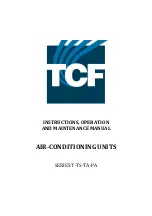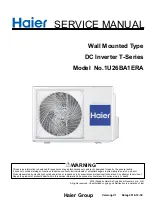
56
Sequence Of Operation (Continued)
Economizer Operation based on Comparative Enthalpy
Comparative enthalpy is accomplished by using an outdoor
humidity sensor (OHS), return humidity sensor (RHS), and
the return air sensor (RAS).
If the outdoor air enthalpy is greater than the return air en-
thalpy, the economizer will not operate and the damper will
not open past the minimum position setting. The economizer
will not operate at outdoor air temperatures above
75° F.
If the outdoor air enthalpy is less than the return air en-
thalpy, the dampers will modulate to maintain a 45° to 55° F
supply air temperature (constant volume or variable air vol-
ume applications). The ECA modulates the economizer
dampers from minimum position to fully open based on a
1.5° F control point below either the space temperature set-
point for constant volume applications or 1.5° F around the
supply air temperature setpoint for variable air volume ap-
plications. Refer to Table 26 for the Humidity versus Voltage
Input Values.
If either or both the return air humidity sensor (RHS) or the
return air sensor (RAS) fails, the economizer will operate
using the reference enthalpy setpoint perimeters.
Gas Heat Sequence Of Operation
When heating is required, the RTRM initiates the heating
cycle through the ignition control module (IGN). The IGN
normally open contacts close to start the combustion blower
motor (CBM) on high speed. Next, the IGN control ener-
gizes the hot surface igniter (IP) for 45 seconds. After a pre-
heat period, the gas valve (GV) is energized for approxi-
mately 7 seconds. If the burner lights, the gas valve re-
mains energized. If the burner fails to ignite, the ignition
module will attempt two retries and then lock out if flame is
not proven. The unit will attempt to ignite at 60 minute inter-
vals until the heating call is removed.
An IGN lockout due to flame loss can be reset by:
1. Open and close the main power disconnect switch.
2. Switch the MODE switch on the zone sensor to “Off” and
then to the desired position (VAV units – remove and re-
apply the mode input).
3. Allow the IGN to reset automatically after one hour.
When ignition takes place, the hot surface igniter (IP) is de-
energized and functions as the flame sensor. If, after 60
seconds, the unit requires 1
st
stage heating only, the IGN
will change the combustion blower from high speed to low
speed. If additional heating is required and first stage heat
has been operating for a minimum of 10 seconds, the IGN
inducer relay will change the combustion blower motor
(CBM) to high speed, delivering second stage heat capacity.
Constant Volume (CV) unit fan operation
If the Fan selection switch is in the “AUTO” position for con-
stant volume units, the RTRM will delay starting the supply
fan for 30 seconds to allow the heat exchanger to warm up.
When the zone temperature rises above the heating
setpoint, the IGN control module will terminate the heat
cycle. The supply fan remains energized for an additional
90 seconds.
Variable Air Volume (VAV) unit fan operation
During any heating mode the VFD or IGV must be at 100%.
Therefore, before the unit can heat, the VHR relay must
have been energized for at least 6 minutes to ensure that
the VAV boxes have driven to maximum. For example, 6
minutes after a Daytime Warmup mode is initiated, the VFD /
IGV output will go to 100% and then the heat cycle will be-
gin. The VHR relay is energized during Unoccupied mode,
Morning Warmup mode, and Daytime Warmup mode. This
6 minute delay before ignition applies to TEST mode also.
Ignition Control Module
There is a green LED located on the ignition module. Any
time the Ignition module is powered, the LED will be on to
provide status of the ignition system.
•
Steady OFF - no power/ internal failure
•
Steady ON - no diagnostic, no call for heat
•
Slow flash rate ¾ second on, ¼ second off - normal call
for heat
Error Code Flashes-
•
One flash - Communication loss between RTRM and IGN
•
Two flashes - System lockout; failed to detect or sustain
flame (3 tries, lockout after 3rd try)
•
Three flashes - Not used
•
Four flashes - High limit switch TCO1, TCO2, or TCO3
open (auto reset)
•
Five flashes - Flame sensed and gas valve not energized;
or flame sensed and no call for heat (auto reset)
The pause between groups of flashes is approximately two
seconds.
High Temperature Limit Operation and Location
All of the heater limit controls are automatic reset. The high
limit cutouts (TCO1) and/or (TCO3) protect against abnor-
mally high supply air temperature. The fan failure limit
(TCO2) protects against abnormally high heat build up due
to excessive high limit (TCO1) (TCO3) cycling if the indoor
fan motor (IDM) fails. If TCO1, TCO2, or TCO3 open during a
heating call, the heat will shut down and the supply fan will
be forced to run. The heat will automatically restart should
the TCO circuit re-close during an active heating call. While
the TCO circuit is open, a heat fail diagnostic will be sent
from the IGN to the RTRM.
The TCO1 and TCO3 is located in the bottom right corner of
the burner assemblies on both downflow and horizontal
units. TCO2 is located on the IDM partition panel; below
and to the right of the blower housing on downflow units.
On horizontal units, TCO2 is located on the IDM partition
panel above the blower housing.
Содержание Voyager RT-SVX17C-EN
Страница 8: ...8 Figure 1 Unit Dimensions for TC_ TE_ and YC_330 360 and 420 MBH Units Low Heat ...
Страница 9: ...9 Figure 1 continued Unit Dimensions for YC_330 360 and 420 MBH Units High Heat ...
Страница 10: ...10 Figure 1 continued Unit Dimensions for TC_ TE_ and YC_480 and 600 MBH Units Low High Heat ...
Страница 24: ...24 Figure 10 Typical FieldWiring Requirements for CV Control Options ...
Страница 78: ......
Страница 79: ......
Страница 80: ......
















































